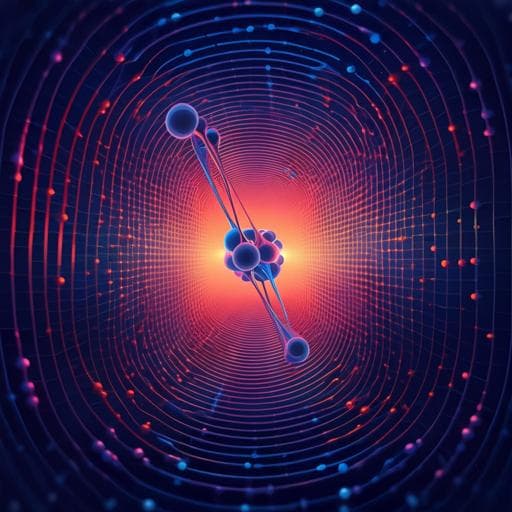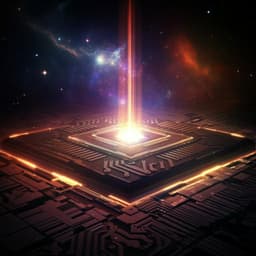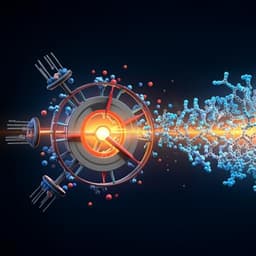
Physics
Violation of Bell inequality by photon scattering on a two-level emitter
S. Liu, O. A. D. Sandberg, et al.
This groundbreaking research by Shikai Liu and colleagues unveils the generation of photonic quantum entanglement using a single two-level emitter in a nanophotonic waveguide. Their innovative approach harnesses efficient optical coupling to create energy-time entanglement, marking a significant step for quantum technology.
~3 min • Beginner • English
Introduction
The study explores whether the intrinsic nonlinearity of a single two-level quantum emitter, deterministically coupled to a nanophotonic waveguide, can generate non-local photonic entanglement via weak (single-photon-level) excitation. Prior work demonstrated nonlinear effects such as antibunching, squeezing, and photon bound states across various emitters, but it remained open whether these nonlinearities could produce genuine non-local entanglement under weak excitation. The authors consider a semiconductor quantum dot (QD) in a photonic crystal waveguide (PhC WG), where efficient radiative coupling (high β factor) enhances photon–photon interactions. They propose and test an energy-time entanglement mechanism arising from inelastic two-photon scattering, probed via a Franson interferometer and quantified with a CHSH Bell inequality test.
Literature Review
The paper situates itself within waveguide QED and quantum nonlinear optics. It references demonstrations of quantum nonlinear phenomena with emitters such as semiconductor QDs, color centers, atoms, and molecules, including antibunching, quadrature squeezing in resonance fluorescence, two-photon correlation dynamics, and photonic bound states. It contrasts prior entanglement-generation approaches using strong excitation (Mollow regime) or QD biexciton radiative cascades with the present passive, weak-excitation scattering approach. The method is positioned as a high-efficiency alternative to parametric sources based on χ(2)/χ(3) processes and four-wave mixing, avoiding strong pumps and complex, decoherence-sensitive pumping schemes while providing access to non-Gaussian operations sought in continuous-variable quantum computing.
Methodology
- Device and sample: A single InAs QD embedded in a suspended GaAs photonic crystal waveguide (PhC WG) forming a p-i-n diode heterostructure (180 nm membrane). Two shallow-etched grating (SEG) mode adapters couple light in and out. The sample operates at 4 K in a cryostat.
- Coupling and enhancement: The QD is deterministically coupled to a single guided mode with extracted coupling efficiency β ≈ 92% and Purcell factor F_p = 15.9, giving a total decay rate Γ/2π ≈ 2.3 GHz (vs ~0.14 GHz in bulk). The radiative rate into the waveguide is γ with β = γ/Γ. Under ideal β → 1 and negligible decoherence, single photons are elastically reflected while two-photon components undergo inelastic forward scattering.
- Input field: A weak coherent state (continuous-wave laser) resonantly drives the QD far below saturation (mean photon number within the emitter lifetime n ≪ 1). Laser linewidth Γ_L/2π ≈ 100 kHz implies coherence time τ_p > 1 µs.
- Two-photon scattering picture: In frequency space, the two-photon output |2, ω⟩ exhibits a Lorentzian two-photon spectrum J(ω − ω_p) ∝ −4β^2/[1 + 4(ω − ω_p)^2], with anti-correlated joint spectral intensity due to energy conservation. In time, the biphoton correlation time is set by the QD lifetime τ_QD ≈ 69 ps, and the process can be viewed as one photon exciting the emitter and a second inducing stimulated emission, leading to bunching in transmission.
- Spectral filtering: A narrow-band notch filter suppresses residual laser leakage arising from non-unity β and slow spectral diffusion, enabling selection of the inelastically scattered component.
- Interferometric analysis: The transmitted light is split to two unbalanced Mach–Zehnder interferometers (UMZIs) for Franson interference. Each UMZI has path delay τ_l = 3.6 ns (≫ τ_QD and ≪ τ_p), defining early/late time bins. Phases φ_s and φ_l are independently controlled and actively stabilized via auxiliary lasers and PID feedback (with PBS, HWP/QWP, polarizer, piezo mirror) to maintain phase lock during acquisition.
- Measurements:
• Transmission vs detuning measured after a UMZI at φ = 0 (constructive for residual laser) and φ = π (destructive for residual laser) to isolate inelastic scattering.
• Second-order correlation g^(2)(τ) of transmitted light on resonance to quantify two-photon component; strong bunching indicates nonlinear two-photon processes.
• Time-resolved coincidence histograms from the two UMZIs to observe three peaks (l,s), (s,s)/(l,l), (s,l) and interference of the central peak when φ_s + φ_l is varied.
• Phase scans of φ_l at fixed φ_s to extract Franson visibility.
• CHSH Bell test: Correlation functions E(φ_l, φ_s) built from combinations of unnormalized g^(2) at four phase settings; compute S = E(φ_l, φ_s) + E(φ_l, φ_s′) − E(φ_l′, φ_s) + E(φ_l′, φ_s′). Pump power and mean photon number n calibrated by fitting transmission data.
- Theory: Complete theoretical model provided (Supplementary), including dependence of the Bell parameter on coupling β, pure dephasing γ (relative to Γ), and mean photon number n. In the limit β → 1, S(β) ≈ 2√2[1 − (1 − β)^4], showing robustness to coupling loss.
Key Findings
- Clear isolation of inelastic two-photon scattering in transmission using a UMZI phase setting (φ = π), with transmission extinction exceeding 85% for residual laser at φ = 0, evidencing strong coupling to the PhC WG.
- Extracted device parameters: β = 92%; Purcell enhancement F_p = 15.9; QD linewidth Γ/2π = 2.3 GHz; QD lifetime ≈ 69 ps; laser linewidth 100 kHz.
- Strong photon bunching in resonance transmission: g^(2)(0) ≈ 210, demonstrating substantial alteration of Poissonian input statistics via emitter-induced nonlinearity.
- Franson interference with high visibility: V = 95(4)% from sinusoidal fits of the central-peak coincidences as a function of φ_l at two φ_s settings.
- Bell inequality violation: CHSH S = 2.67(16) > 2 by more than four standard deviations at lowest n (pump power ≈ 7.2 pW in the PhC WG), certifying non-local energy-time entanglement generated by the two-photon inelastic scattering process.
- Power dependence: Measured S versus mean photon number n (or pump power) agrees with the theoretical model; entanglement degrades with increasing n due to multi-photon processes and dephasing.
- Theoretical robustness: In the high-β limit, S is only weakly affected by coupling loss, with S(β) ≈ 2√2[1 − (1 − β)^4].
Discussion
The results demonstrate that the intrinsic nonlinearity of a single, deterministically waveguide-coupled two-level emitter suffices to generate non-local energy-time entanglement between scattered photons under weak excitation. The experimentally observed high Franson visibility and a CHSH parameter S significantly above 2 confirm the research hypothesis that inelastic two-photon scattering can create entanglement without strong driving or complex spin control. The approach leverages waveguide interference: ideally, single photons are reflected while photon-bound states are transmitted, enabling non-Gaussian operations at the single-photon energy scale. Compared with conventional χ(2)/χ(3) parametric sources, the passive scattering scheme promises higher power efficiency and potentially far higher spectral brightness. The agreement between experiment and theory, including the dependence of S on β, dephasing, and n, underscores the feasibility and scalability of on-chip entanglement sources based on solid-state emitters.
Conclusion
The study reports the first experimental violation of the CHSH Bell inequality using energy-time entangled photons generated by weak, passive scattering from a single two-level emitter integrated in a photonic crystal waveguide. Key achievements include strong photon bunching, high interferometric visibility, and S = 2.67(16), validating non-local correlations induced by emitter-mediated two-photon interactions. The method avoids active spin control and strong pumping, offering a simple, power-efficient route to on-chip entanglement with potentially high spectral brightness and access to non-Gaussian photonic operations. Future work could target high-dimensional entanglement, engineered many-body subradiant states using coupled QDs, and the synthesis of tailored photonic quantum states for quantum simulators, quantum communication, sensing, and quantum-optics neural networks.
Limitations
- The Bell test assumes fair sampling and is not loophole-free.
- Entanglement quality is limited by photon distinguishability from pure dephasing and by multi-photon scattering at finite mean photon number n.
- Non-unity β and slow spectral diffusion necessitate narrowband spectral filtering to suppress residual laser leakage.
- Decoherence processes and finite coupling reduce the ideal reflection of single photons, lowering the achievable S compared with the theoretical maximum 2√2.
Related Publications
Explore these studies to deepen your understanding of the subject.







